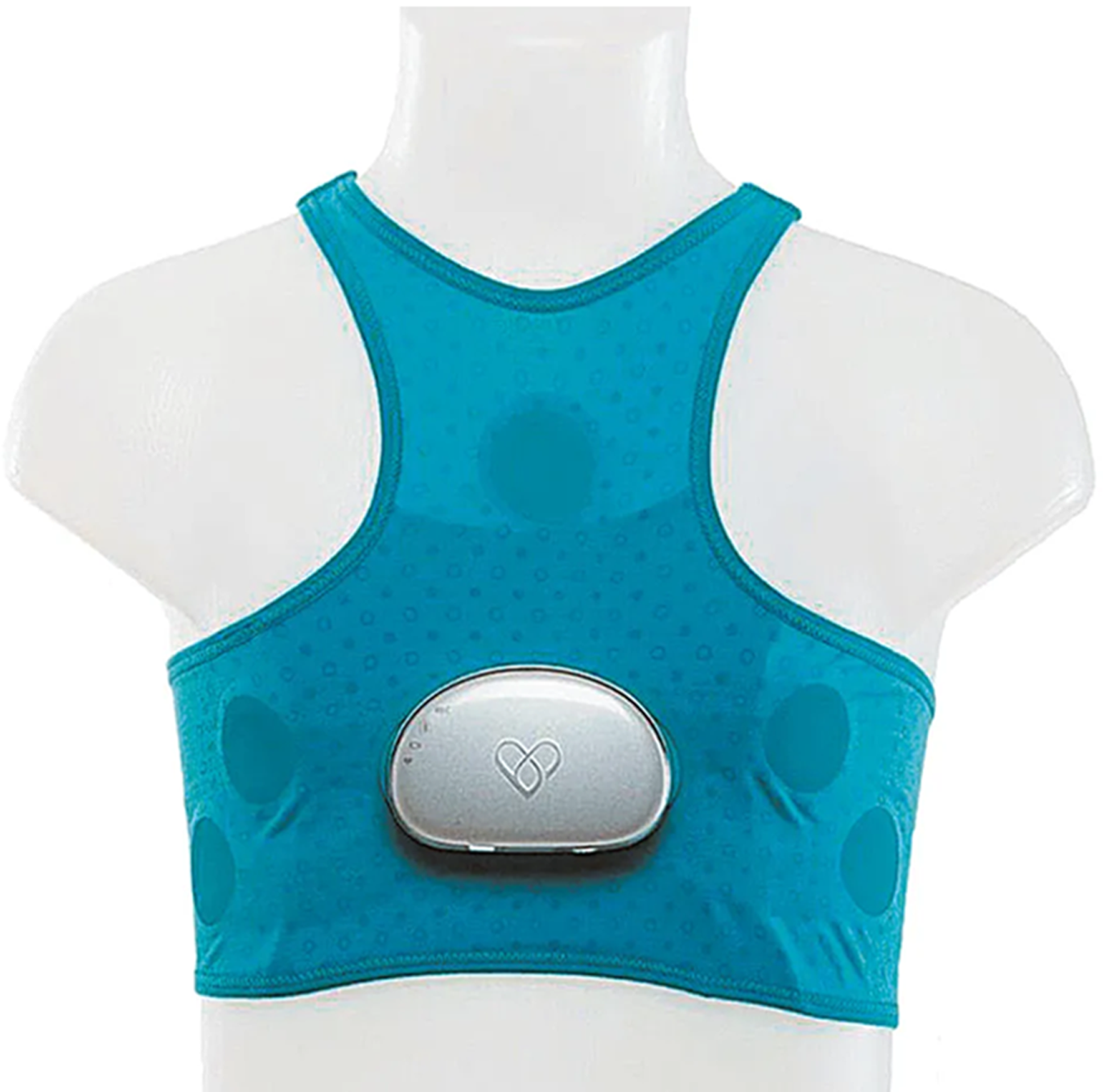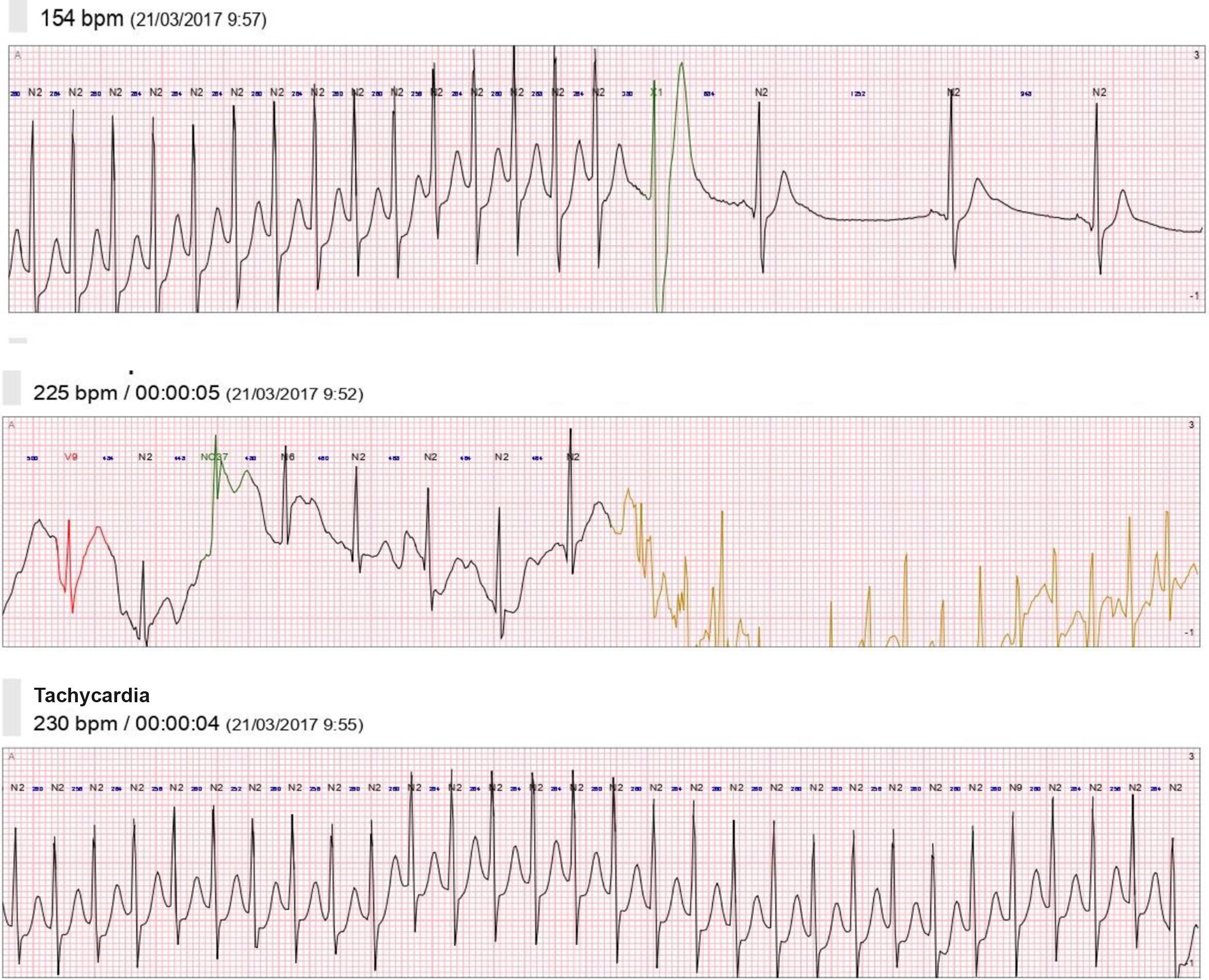Arrhythmias in paediatric age is most of the times challenging, the episodes of short duration, such as the difficulty in the communication of symptoms by the pediatric patient can lead to delays in their diagnosis and timely treatment. The use of the 24-hour Holter monitoring offers limited performance, due to the rare occurrence of symptoms and their short time of use. Nuubo ™ Vest is a 5-electrode system consisting of an electronic device (nECG minder) attached to the garment transmitting the electrocardiography signal via bluetooth to a computer, a shirt that captures the electrocardiography signal via textile electrodes (nECG Vest) (Fig. 1) with data analysis via the nECG minder which must be charged for 30 minutes each day. Patient-triggered clinical events are recorded by pressing/tapping the device. This device has the potential for long duration monitoring (up to 90 days). Reference Eysenck, Freemantle and Sulke1 We present this case using the Nuubo ™ Vest device.
Case presentation
An 11-year-old male patient who was referred to the paediatric cardiology outpatient clinic due to episodes of palpitations and chest pain for about a year; episodes of short duration between 1 and 2 minutes that appear approximately every 4–8 weeks without a clear pattern of presentation subside spontaneously. Occasionally with a feeling of subsequent fatigue, dizziness and headache, not related to any special effort or exercise, have generally appeared in situations of rest. He has consulted his health centre on different occasions. The patient has no history of 1st degree relatives with sudden death or medical history of congenital heart disease, no surgical history, and no allergies were found. At the paediatric cardiology ambulant consult, the physical examination was normal. The electrocardiogram sinus rhythm was 75 bpm, QRS axis = 60º, PR interval = 0.12 seconds, QRS = 0.08 seconds, and QTc = 420 ms. Also, no Delta wave and signs of ischemia were observed (Fig. 2). 2D echocardiography and color Doppler were within the limits of normality. A good ventricular function was observed. A paroxysmal supraventricular tachycardia was suspected. A complete metabolic panel, haemogram, and thyroid hormones were performed. The results were normal. A Nuubo ™ Vest was placed for 33 days. A follow-up visit was scheduled. During the follow-up, the patient presents an episode of paroxysmal supraventricular tachycardia (Figs. 3 and 4). It is electively programmed for electrophysiological study and potential ablation where an accessory hidden pathway is found in the right posterolateral area. The patient in his follow-up 1 year after the ablation has been asymptomatic.
The follow-up every 4 months has been carried out and Holter Nuubo™ was placed for 2 weeks. No arrhythmias were found.

Figure 1. Nuubo ™ Vest electrocardiogram recorder.

Figure 2. 12-lead electrocardiogram.
Note: Sinus Rhythm, PR interval = 0.12 seconds, QRS = 0.08 seconds, QTc = 410 ms, no Delta wave, normal repolarisation.

Figure 3. Heart beat monitoring.

Figure 4. Nuubo ™ Vest ECG trace with paroxistic supraventricular 5-minute episode.
Discussion
Paroxysmal supraventricular tachycardia is the most frequent arrhythmia in Paediatrics and it is a medical emergency. It happens in 0.1–0.4% of the children, mostly as an accidental finding or palpitations, it is well tolerated and sometimes with a spontaneous resolution. The identification and diagnosis the episodes of short duration, such as the difficulty in the communication of symptoms by the child is most of times challenging. The use of the 24–48 hours Holter monitoring offers limited performance, due to the rare occurrence of symptoms and their short time of use. The use of the Nuubo ™ Vest was reported in adult population for diagnosing and monitoring different clinical situations like congestive heart failure, atrial fibrillation, cardiac resynchronisation therapy and also in patients with ischemic heart disease and home-based cardiac rehabilitation programmes. Reference Basalm2,Reference Pala3,Reference Bravo Escobar4 The Nuubo Vest can be a very useful tool in cardiovascular screening in competitive sports. Reference Fabregat-Andres5
Many electronic cardiac monitoring devices like wearable or implantable technologies are now available. The advances in cardiac monitoring devices in real time enable to improving the diagnosis of cardiac arrhytmias in a precise and timely manner.
Conclusion
The Nuubo ™ Vest system proves to be a useful tool in the diagnosis of paediatric arrhythmias, or patients with any other suspected rhythm disorders covering a wide age and size range. The monitoring was adapted to individual patient’s needs. The Nuubo showed good quality and precise detection of arrhythmias. We consider that the Nuubo ™ Vest technology allows an accurate 3-lead electrocardiographic recording, and provides a new perspective in the diagnosis of paediatric arrhythmias.
Acknowledgments
The authors would like to thank the staff of the pediatric and cardiology service of the parc tauli hospital.
Financial support
No specific grant from any funding agency, commercial, or not-for-profit sectors.
Conflicts of interest
None.
Ethical standards
The manuscript is an original work of all authors. All authors made significant contribution and have read and approved the final version of the manuscript.
Patient
Informed consent and a satisfaction survey was done in this case.







